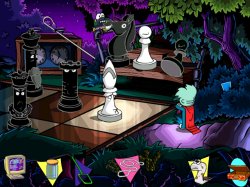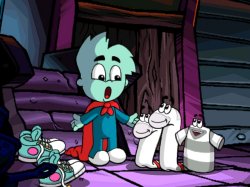|
Pajama Sam: Life is Rough When You Lose Your Stuff!
 Corporate life being what it is, Pajama Sam is now part of the Atari stable. I am pleased to say that everything that made him such a hit in his previous three adventures remains in place. "If it ain't broke..." has clearly been the approach, and Sam remains exactly as he was.
The theme this time is dirt and grime. Pajama Man is appearing at the mall, and Sam is desperate to get his hero's autograph on a suitable piece of memorabilia. His first edition comic book is just the thing, but when the comic sinks into a pile of mess in Sam's room, Sam must follow it into a world of trash and untidiness. Could Dr Grime be behind it all?
In the world within the mess that is Sam's bedroom, Dust Bunnies rule. Somewhere there is Sam's comic, but finding and retrieving it was never going to be easy.
The Pajama Sam games have won many awards, and deservedly so. Read any of the previous reviews and the same holds here. Sam's adventures are bright and full of activity, populated by interesting and jolly characters. Aimed at ages 5 to 8, they hit the mark perfectly, but are fun for kids of all ages. Clare who is 10 enjoyed this one immensely, and 14 year old Emily took it to play when Clare was done (about 2 hours later). Corporate life being what it is, Pajama Sam is now part of the Atari stable. I am pleased to say that everything that made him such a hit in his previous three adventures remains in place. "If it ain't broke..." has clearly been the approach, and Sam remains exactly as he was.
The theme this time is dirt and grime. Pajama Man is appearing at the mall, and Sam is desperate to get his hero's autograph on a suitable piece of memorabilia. His first edition comic book is just the thing, but when the comic sinks into a pile of mess in Sam's room, Sam must follow it into a world of trash and untidiness. Could Dr Grime be behind it all?
In the world within the mess that is Sam's bedroom, Dust Bunnies rule. Somewhere there is Sam's comic, but finding and retrieving it was never going to be easy.
The Pajama Sam games have won many awards, and deservedly so. Read any of the previous reviews and the same holds here. Sam's adventures are bright and full of activity, populated by interesting and jolly characters. Aimed at ages 5 to 8, they hit the mark perfectly, but are fun for kids of all ages. Clare who is 10 enjoyed this one immensely, and 14 year old Emily took it to play when Clare was done (about 2 hours later).
 As an introduction to adventure games, these games couldn't be much better. As an aid to deductive learning and strategic thinking they are wonderful. Look and listen, make and help friends, and have fun.
Game play is simplicity itself. Point and click, aided by an active icon. Move the cursor to the bottom of the screen, and the inventory and menu screen pop into view. Paste an image of your current screen to save your position.
Like all Humongous games, there is much to do within the game. Wacky little animations occur when clicking on objects for no reason other than they are fun. Mini-games exist at various places in the game that can be played over and over should you want to do so. And Sam is also on a treasure hunt for his trading cards. Each one can in fact be printed. Find them all and you get a final congratulatory prize.
To enhance replayability, items will be in different places if you start a new game. And to top it all off, a sock sings a show stopping tune to which the lyrics are in the manual so you can all sing along. As an introduction to adventure games, these games couldn't be much better. As an aid to deductive learning and strategic thinking they are wonderful. Look and listen, make and help friends, and have fun.
Game play is simplicity itself. Point and click, aided by an active icon. Move the cursor to the bottom of the screen, and the inventory and menu screen pop into view. Paste an image of your current screen to save your position.
Like all Humongous games, there is much to do within the game. Wacky little animations occur when clicking on objects for no reason other than they are fun. Mini-games exist at various places in the game that can be played over and over should you want to do so. And Sam is also on a treasure hunt for his trading cards. Each one can in fact be printed. Find them all and you get a final congratulatory prize.
To enhance replayability, items will be in different places if you start a new game. And to top it all off, a sock sings a show stopping tune to which the lyrics are in the manual so you can all sing along.
Despite being slightly older than the target audience, Clare did not breeze through. There was more than one pause for some thought, and some re-tracing of steps to see what might have been missed.
For younger players, the manual provides huge amounts of help if stuck, but the game is constructed in a way that helps itself. Sam will often provide an insight when trying to nut out a problem. For example, an item that is needed might be stuck. Getting Sam to try again might elicit a response along the lines of "I need something to help me get it loose". So the search begins, but further unsuccessful attempts might cause Sam to muse on what sort of thing his Mum has used to get such things unstuck. The young player might well remember seeing one of those things somewhere else, and the problem is solved.
There are some multi-part solutions to various of Sam's problems, and Sam might well have to gather information from all over the messy world before finding a way to move on. Sam might also have to do certain things in order; the Bunny Farmer simply won't be there until certain information is obtained, and you cannot get holes punched in your jar no matter how hard you try until you know why you need them punched. It ensures the rationale for the action is known and explained, but perhaps mitigates against the unusually perceptive player.
If that is the only quibble, the game is clearly a winner. But don't take my word, ask Clare:
"I liked it a lot. I have played all the Pajama Sam games and would recommend them. Freddi Fish and SpyFox I would recommend as well. The trading cards were good to find and had funny things written on them. The Soiled Sock song made me laugh, and the blue sponge was pretty cool. Stopping the ice cube melting was the hardest puzzle. I think 5 year olds would need a parent to help but they would still have lots of fun".
Copyright © Steve Ramsey with Clare 2003.
All rights reserved.
System requirements:
Windows 98/Me/2000/XP, Pentium II 350 MHz or higher, 48 MB RAM (64 MB for XP)
160 MB Free hard disk space, 8 Speed CD-ROM Drive, 4 MB SVGA video card,
sound card, DirectX(r) version 9.0 (included) or higher.
|
